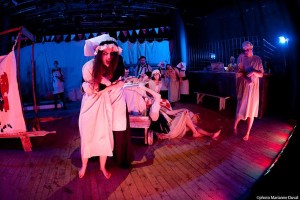Marat-Sade: An energetic, well-balanced production of Peter Weiss’ play

It took about a hundred years for Marquis de Sade (Donatien Alphonse François de Sade) to become a figure of great interest and even greater controversy. His sadistic nature (the expression sadism is derived from his name due to his writings and behaviour) and immoralitym completely unacceptable by any social standards, caused him imprisonment more often than not. He spent his last years of life incarcerated in Charenton asylum (Val-de-Marne, France), where he wrote and directed plays with its inmates as actors.
In the 20th century, artists celebrated him as a founder of free expression in erotic literature; Guillaume Apollinaire even called him “the freest spirit that has yet existed.”
His writings, full of sexual fantasy combined with philosophy of pornography with an emphasis on violence, repel some and fascinate others to this day.
Sade’s life and philosophy inspired many, among them German writer Peter Weiss, who wrote the play The Persecution and Assassination of Jean-Paul Marat as Performed by the Inmates of the Asylum of Charenton Under the Direction of the Marquis de Sade (shortened version “Marat-Sade” ) in 1963. The plot is set inCharenton asylum in 1808, where Marquis de Sade directs a play about the death of the popular French Revolution leader Jean Paul Marat. Conceptualized as a play within a play, this sharp political theatre deals with abuse of power and the meaning of revolution. In the wake of Artaud and Brecht vision of theatre, he uses the environment of chaos and madness to show human suffering and class struggle, as well as to question the role of the true revolution – should it change socity and where should the change come from: from the histrorical event itself of from ourselves?
Whatever the genre, complexity or approach to the play, in theatre one rule always stays the same: the story (or the idea) has to be centre stage! This is an extremely challenging task with a play of such complexity: it is not a play about people and events but about ideas; it is purely philosophical and it is performed in a manner of physical theatre. A wild beast was unleashed on the stage of Ottawa University, but James Richardson took the beast by the horns and tamed it!
The stage was boiling hot with excitement and drama, threatening to explode even in the quietist moments. A cast of about 30 actors acted their parts consistently and constantly throughout the performance, each actor living his or her character’s life – complete with tormented soul and mind – with passion and fierceness. Richardson balanced heated and cold moments superbly. The transitions were seamless and the pace was perfect. The scenes of madness and chaos were realistic and powerful. It was a lunacy, which took the form of hidden sanity through which the idea of corrupt and abusive political reality was fully developed. Talents such as Annik Walsh as Herald, Julie Malenfant as Marat’s nurse, and Jérémie Cyr-Cooke as Jean-Paul Marat added greatly to the success of the show. Musical scores, although very entertaining, were also completely functional, underlining the idea of justice, belief and betrayal.
Beautifully sang, altogether well acted, it was the kind of theatre we wish to see more often in Ottawa.
Marat-Sade
by Peter Weiss
Directed by James Richardson
Set Graham Price,
Musical director, Nick Carpenter
Lighting design, Margaret Coderre Willliams
Props, Even Gilchrist
Original music: Richard Peeselee
CAST:
Jean-Paul Marat Jérémie Cyr-Cooke
Charlotte Corday Emma Hickey